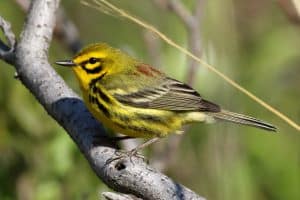Share this article
Restoration of Pine-Oak Woodlands in Missouri — from The Wildlife Professional
Using Science to Inform Land Management Debates and Decisions
On a warm July day in 2014, our group headed out to a field tour on the Mark Twain National Forest. The purpose of the trip was to learn firsthand what stakeholders thought of the Missouri Pine-Oak Woodlands Restoration Project. As wildlife ecologists and foresters, we were well aware of the conservation issues for this ecosystem and the ecological benefits of restoring open forests. On this visit we heard conservation agencies, an NGO, and even a local landowner voice their support for the project. It soon became clear, however, that not everyone agreed with the goals or the management practices being implemented on approximately 6 percent of this forest in southeast Missouri (USDA Forest Service 2011).
A representative from the Missouri Forest Products Association spoke up. His group was not happy about the increased emphasis on shortleaf pine restoration over oak management. Pine is less common and valuable than oaks, so they wanted to see greater emphasis on reducing mortality of black, red and scarlet oaks and harvesting those that were approaching the end of their natural longevity.
Missouri Congressman Jason Smith (R) questioned the safety of prescribed fires and their need. He worried the fires were too big and their effects too uncertain, causing damage to the forest and its wildlife. Members of Missouri’s congressional delegation subsequently placed a hold on prescribed burning on the forest until a report on the economic impact of restoration could be produced.
The concerns we heard that day — along with those that surfaced in other forums — prompted our group to collaborate with more than a dozen organizations to launch scientific investigations into four leading issues. Our experience illustrates how a science-based, collaborative approach can help inform and resolve what may seem like insurmountable conflicts among managers and stakeholders.
What is a woodland?
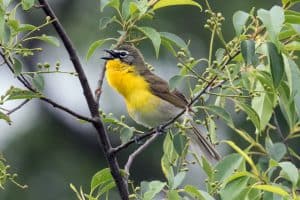
Many bird species, such as the prairie warbler and yellow-breasted chat responded positively — as documented by greater abundance and nest success — to management treatments established by the Missouri Pine-Oak Woodlands Restoration Project. ©John Figlar
Woodlands are characterized by 30 to 90 percent canopy cover, an open midstory and diverse ground cover consisting of grasses, forbs and shrubs. Historically, frequent fires and grazing maintained the open canopy and midstory characteristic of woodlands.
Millions of acres of old growth shortleaf pine woodlands once covered parts of the southern Missouri Ozarks, particularly on lands that are now part of the Mark Twain National Forest. Logging in the late 1800s and early 1900s removed most of the pine woodland overstory, and that, along with effective fire suppression and the end of open-range grazing, facilitated recruitment and growth of young oaks that that filled the midstory and eventually converted pine-oak woodlands to oak forests.
The once-common pine-oak woodland is now scarce on the landscape and restoring it can increase diversity of wildlife, plants and forest structure. In addition, increased diversity can impart greater resilience when forest ecosystems are disturbed by reducing the severity of wildfires, for example.
This set of forest conditions and concerns is not unique to Missouri. The Shortleaf Pine Initiative, launched in 2013, focuses on restoration of shortleaf pine throughout its range in the eastern United States.
Woodlands and wildlife
One of the major concerns of stakeholders was the potential impacts of the project on wildlife. Pine-oak woodland restoration potentially degrades habitat for late-successional forest birds. Stakeholders worried that the restoration project might not generate enough of a disturbance to create habitat for early successional or disturbance-dependent birds that benefit from traditional forestry practices like clearcutting.
To address these concerns, we worked with the Mark Twain National Forest, Missouri Department of Conservation, LAD Foundation, Central Hardwoods Joint Venture, and Melissa Roach, a graduate student at the University of Missouri, to survey bird abundance at 338 points and monitor the success of 462 nests in the project area. The surveys showed that woodland restoration management provided habitat for most of the region’s disturbance-dependent birds and woodland generalists with only a small reduction in the abundance of late-successional forest birds. The data revealed that the abundance of disturbance-dependent birds such as Eastern towhee (Pipilo erythrophthalmus), Eastern wood-pewee (Contopus virens), pine warbler (Setophaga pinus) , prairie warbler (Setophaga discolor), red-headed woodpecker (Melanerpes erythrocephalus), white-eyed vireo (Vireo griseus), yellow-breasted chat (Icteria virens), blue-winged warbler (Vermivora cyanoptera), and Kentucky warbler (Geothlypis formosa) were positively related to some combination of prescribed burning, thinning or more open canopy cover.
In contrast, late-successional birds such as the Acadian flycatcher (Empidonax virescens), wood thrush (Hylocichla mustelina), and worm-eating warbler (Helmitheros vermivorum) were negatively related to restoration treatments and preferred areas with greater tree density and canopy cover (Roach 2016).
Nest success of Eastern towhee, prairie warbler, yellow-breasted chat, Eastern wood-pewee, summer tanager (Piranga rubra), and pine warbler was positively related to tree thinning, prescribed burning or the resulting woodland vegetation structure (Roach et al., 2018). Most importantly, the study showed that landscapes composed of a mix of savanna woodland and forest would provide quality habitat for all of these species.
The effects of fire and harvesting
The pine-oak woodlands that dominated the southeastern Missouri region in the early 1800s were created and maintained by periodic fires. At the time, timber harvesting was not prevalent. Stakeholders questioned whether simply reintroducing historic fire regimes could recreate and maintain the historic pine-oak woodland structure and its composition of species.
We worked with the University of Missouri and Mark Twain National Forest to apply a forest landscape model, known as LANDIS, to analyze expected outcomes over a century of management under alternative scenarios, including with and without timber harvesting and prescribed burning (Jin et al. 2017). The model simulations suggested that both prescribed burning and timber harvesting were required to restore and sustain pine-oak woodlands in the landscape. Without any proactive management actions, the project area would likely become dominated by oak forest.
Analyzing the economic impacts
Silvicultural practices to create and maintain pine-oak woodlands — namely, thinning trees and repeated prescribed burning — require a significant financial investment, including personnel to do the work. While harvested products can generate revenue, stakeholders worried that the revenue from thinning would not be sufficient to offset the costs of environmental analyses and timber sale preparation and administration.
Over a 10-year period, we estimated that the U.S. Forest Service and its collaborators would invest more than $20 million to implement the restoration project. About half that amount is new funding targeted exclusively for the pine-oak woodland project and half is matching funding from other Mark Twain programs, agencies and NGOs.
To respond to stakeholders concerns, the Mark Twain National Forest commissioned an economic analysis of the project. The results showed that the $20 million investment spanning 2012 to 2019 is expected to support 138 jobs per year and generate an 8-year total of $34 million in labor income. Moreover, there would be an additional $10 million in value added as workers spent wages on food, entertainment, fuel, housing and other items that would help the expenditures on forest management to ripple through the local economy (Song and Aguilar 2015). The net result was approximately $2.20 of local economic activity for every dollar invested in the project.
In addition, the analysis predicted that the merchantable volume of standing timber on the area would increase by approximately 14 percent over the eight-year period, in spite of the periodic timber harvesting required to open the forest overstory. Given that some of the management activities would take place with or without the restoration project, the net added value exclusively due to new activities was estimated at $28 million.
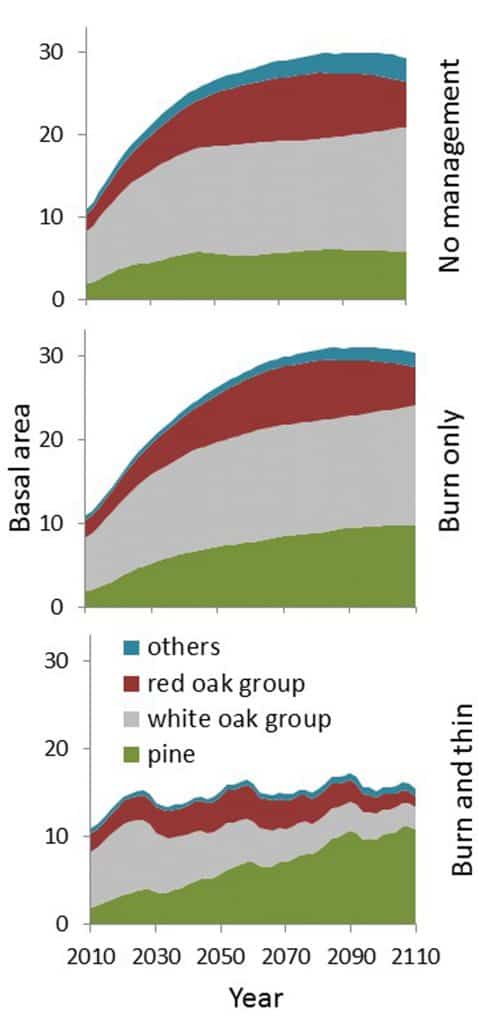
The graphs show a forest landscape change model used to evaluate pine-oak woodlands restoration scenarios. To restore and maintain a woodland structure with pine as the dominant tree species, a combination of periodic thinning and prescribed fire were required. Source: Adapted with permission from (Jin et al. 2017).
Restoration during climate change
The impacts of climate change on the restoration project also worried stakeholders. Exploitative timber harvests in the 19th and early 20th centuries removed pines, which were then replaced by naturally regenerated oak forest. As this second-growth oak forest matured, the local forest industry focused heavily on utilization of oaks. In recent decades, oak decline and mortality has increasingly occurred when droughts affect trees in the red oak group that are physiologically mature and growing on dry sites that historically were dominated by pine.
To address these concerns, we worked in collaboration with researchers at the University of Missouri and the U.S Geological Survey’s Northeast Climate Science Center to model forest landscape change under alternative scenarios of climate change and management. We found that for the Ozark Highlands where the Mark Twain National Forest is located — and for Midwest in general — warming temperatures and changing precipitation patterns will be less favorable for many oaks and more favorable for several southern pines. In addition, the model predicts many sites will support lower tree densities.
Overall, the climate analyses suggest that pine-oak woodlands will be more resilient and better adapted to climate change than oak forests.
Putting the science to use
As the four studies were completed, our focus turned to getting the word out and putting the results to use.
We participated in a workshop on shortleaf pine restoration attended by 50 land managers at the 2017 Missouri Natural Resources Conference. We gave presentations on how pine-woodland restoration is affecting birds, the importance of fire and thinning to sustaining pine-woodlands in the landscape, and the economic impacts of pine-woodland restoration.
The results of the economic analysis were submitted in a report to Congress and helped alleviate concerns by state and federal legislators about the impacts of the restoration effort. They ultimately reversed the hold on the use of prescribed fire on the Mark Twain National Forest.
Outreach efforts were also created to help inform the public. The Mark Twain National Forest and partner organizations launched a new auto tour of the project that describes the goals and benefits of pine woodland restoration. Signs and audio playbacks during the tour explain the history, ecology and management of pine-oak woodlands, including some of the benefits to wildlife species of conservation concern and the research that supports the restoration project.

Signs and audio recordings are part of a new auto tour to inform the public about the ecology, management and benefits of pine-oak woodlands on the Mark Twain National Forest in Missouri. ©U.S. Forest Service
The lasting benefits of collaboration
When we listened to stakeholders that July day, we came away with a greater sense of how important it is to have sound science to inform stakeholders and decision-makers. The four collaborative studies aimed at bringing the best available science to guide management decisions suggested the Missouri Pine-Oak Woodlands Restoration Project is improving landscape-scale diversity, sustainability, resiliency and adaption to climate change.
However, determining the scale of pine-oak woodland restoration and where it should be practiced comes down to balancing that which is ecologically possible with that which is socially acceptable and economically viable. This experience has taught us that providing the best possible information to all stakeholders is essential to getting informed input and guiding decisions.
More importantly, as natural resource managers, we need to recognize that it is insufficient to focus solely on the ecological aspects of management decisions. Social and economic concerns are also important and can override management plans that we believe are ecologically sound.
Collaborative Forest Landscape Restoration Program
Congress established the Collaborative Forest Landscape Restoration Program (CFLRP) to encourage the collaborative, science-based ecosystem restoration of priority forest landscapes. Goals of the program include encouraging ecological, economic and social sustainability of forest resources, as well as reducing wildfire management costs by reestablishing natural fire regimes that preempt catastrophic wildfires.
The Mark Twain National Forest — working with 10 other collaborating natural resource agencies and NGOs — received support for the Missouri Pine-Oak Woodlands Restoration Project under the CFLRP. Management is focused on opening the forest overstory and removing midstory trees to bring more light to the forest floor and periodically burning the understory to favor fire-adapted herbaceous species and reduce competition from woody species. Although pines are favored over oaks, oak woodland communities also benefit from periodic prescribed burns.
CFLRP contributed $6.1 million to project and the Mark Twain National Forest allocated $5.9 million from its budget. Other financial support came from in-kind contribution from partners and stewardship contract service work. This money supported tree harvesting on 30,460 acres and prescribed burning 75,452 acres from 2012 to 2017, which is approaching the goal of restoring 88,000 acres of pine and pine-oak habitat.
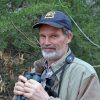 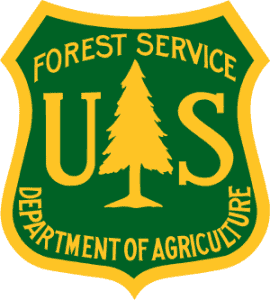 TWS Member, Frank R. Thompson III, PhD, TWS Fellow, is a research wildlife biologist with the U.S. Forest Service Northern Research Station. TWS Member, Frank R. Thompson III, PhD, TWS Fellow, is a research wildlife biologist with the U.S. Forest Service Northern Research Station. |
| Brice Hanberry is a research ecologist with the U.S. Forest Service Rocky Mountain Research Station. |
| Stephen R. Shifley is a research forester with the U.S. Forest Service Northern Research Station. |
| Brian K. Davidson is a natural resource specialist with the U.S. Forest Service, Mark Twain National Forest. |
| William Block, PhD, is a program manager at the USFS Rocky Mountain Research Station, Caesar Kleberg Award recipient, TWS Fellow, and former editor-in-chief of the Journal of Wildlife Management. |
Header Image: A group of representatives from state and federal agencies, NGOs, industry, as well a congressman and other legislative staff take part in a 2014 field tour of the Missouri Pine-Oak Woodlands Restoration Project on the Mark Twain National Forest. Not all the participants were on board with the management goals, which U.S. Forest Service researchers and collaborators to launch scientific investigations. ©Stephen Shifley





